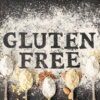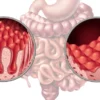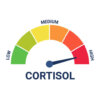
What is IBS?
IBS (irritable bowel syndrome) is described as a functional digestive condition which involves a specific set of symptoms.
The symptoms of IBS include:
- Abdominal pain
- Abdominal discomfort
- Cramps
- Altered bowel patterns
For a diagnosis of IBS, other gut conditions are ruled out. This means, that once conditions such as inflammatory bowel disease, coeliac disease and bowel cancer are excluded, a diagnosis of IBS may then be given. [Source: PubMed]
The exact criteria for an IBS diagnosis are described in the ROME IV criteria. This states that the abdominal pain needs to be present at least 1 day per week over the last 3 months along with:
- The pain is related to defecation (going to the toilet).
- Being associated with a change in stool form.
- Being associated with a change in stool frequency. [Source: PubMed]
For some patients, diarrhoea (IBS-D) can be experienced while in others it may be constipation (IBS-C). Additionally, in others, it’s possible to have mixed stools (IBS-M) indicating a back-and-forth between constipation and diarrhoea. [Source: PubMed]
What is IBS-C?
The overall rate of IBS globally is 4% with a subset of these experiencing IBS-C. This refers to the majority of bowel movements experienced being constipation.
The ROME IV criteria outline IBS-C as being “more than 25% of bowel movements are classified as Bristol Stool Chart 1 or 2, and less than 25% as 6 or 7.“
This indicates that the form of the stool can be:
- Type 1 – Separate hard lumps, like nuts that are hard to pass.
- Type 2 – Sausage-shaped but lumpy.
While there are ways to support bowel movements using laxatives or stool softeners, working to understand and address possible underlying factors can also be considered.
With IBS-C, a range of factors are understood to play a possible causative role in its development.
These can include:
- Changes in gut motility
- Visceral hypersensitivity
- SIBO (small intestinal bacterial overgrowth)
- IMO (intestinal methane overgrowth)
- Environmental factors
- Eating habits
- Food Intolerances
- Dysbiosis (changes in the gut bacteria) [Source: PubMed]
What Food is Good for IBS constipation (IBS-C)?
There are clear guidelines around the dietary and lifestyle factors for IBS with constipation (IBS-C). These are considered ‘first-line’ interventions for the initial set of recommendations to support those with IBS.
These also work to set a firm foundation to support the gut before moving towards more complicated approaches. These dietary recommendations around the best food for IBS-C are compiled from the guidelines set by NICE and the British Dietetic Association.
This can be seen as general advice on addressing and supporting the gut to improve IBS symptoms which includes:
- Eating regular meals and also ensuring to take time to eat.
- Avoid skipping meals or leaving too long between meals.
- Drink at least 8 cups of water or non-caffeinated drinks per day
- Limiting the intake of alcohol and fizzy drinks.
- Limiting the intake of tea and coffee to 3 cups per day total.
- Reduce intake of ‘resistant starch’ (starch that resists digestion in the small intestine and reaches the colon intact), which is often found in processed or pre-cooked foods.
- Limit fresh fruit intake to 3 portions per day (a portion should be approximately 80g). [Source: NICE, PubMed]
These foods high in resistant starch include:
- Oats
- Cooked and cooled rice
- Beans and legumes
- Raw potato starch
- Cooked and cooled potatoes
- Green bananas [Source: PubMed]
These first-line considerations can be a helpful way forward for many with IBS-C. If these prove unhelpful further approaches can then be considered.
The Low FODMAP diet for IBS and Constipation
The low FODMAP diet is a therapeutic dietary approach for the management of IBS. This diet restricts FODMAPs which are sugars or fibres that in certain individuals may be poorly absorbed to inappropriately fermented. This may then lead to symptoms of IBS that include bloating, gas, constipation, or diarrhoea.
While FODMAP-containing foods are considered healthy, imbalances in the gut, for example, SIBO, can lead to these foods being poorly tolerated. However, limiting these in the short term can help to identify specific food triggers to manage IBS symptoms.
High FODMAP foods include:
- Apples
- Wheat
- Garlic
- Onion
- Pears
- Beans
- Lentils
- High lactose dairy
The low FODMAP diet should be used with more caution by those who experience IBS with constipation, rather than diarrhoea. This is because the lower intake of fibre may worsen or increase constipation. [Source: PubMed]
While a low FODMAP diet can reduce IBS symptoms such as gas, bloating and pain a consideration for those with constipation is that an additional source of soluble fibre can be introduced, such as flaxseeds or psyllium husk.
This is to continue to support the fibre content of the diet to support bowel movements. Often introducing these fibres slowly, is important to ensure tolerance. [Source: Wiley]
Soluble or Insoluble Fibre for IBS-C
Fibre plays a role in the development of IBS with studies indicating a low-fibre diet can increase the risk of IBS. [Source: PubMed]
Dietary fibre can be described in 3 categories:
- Insoluble and not very fermentable fibres (e.g. whole grains)
- Soluble, non-viscous and readily fermentable fibres (e.g. inulin)
- Soluble, gel-forming and non-fermentable fibres (e.g. psyllium) [Source: PubMed]
These fibres act in different ways within the gut and depending on the individual can impact IBS symptoms.
While insoluble fibres can increase transit time and the total mass of the stool, soluble fibres are gel-forming which can act in a way to support the normalisation of bowel movements and stool form, particularly in constipation.
This can be seen as these fibres forming a gel in the bowel which acts to lubricate bowel movements by increasing the water content of the stool. [Source: PubMed]
Psyllium Husk for Constipation
Supplementing with fibres (such as psyllium husk) is considered a first-line approach to managing chronic constipation. However, certain types of fibres can be more beneficial than others.
How well the fibres are tolerated is partly due to how fermentable they are. This is due to the gut bacteria producing gas that these fibres are digested which may lead to bloating and discomfort.
Various prebiotics such as PHGG and Inulin have been studied alongside Psyllium husk. The results of these studies have been that Psyllium husk is the best tolerated and most reliable at improving constipation.
It was also responded that the doses of 10g per day (or greater) lead to the most effective improvements in constipation. [Source: PubMed]
On average, this dose led to an increase of 3 bowel movements per week. This means that psyllium husk may be more effective than laxatives which on average leads to an improvement of 2.5 bowel movements per week. [Source: PubMed]
While studies found that supplementing psyllium husk fibre helped with improving bowel movements, participants did not see improvements in some of the other symptoms of IBS. For example, pain, discomfort and bloating as well as the sensation of incomplete evacuation.
This may mean that Psyllium husk may be better suited to those with symptoms of constipation that include:
- Straining to go to the toilet.
- Hard tools.
- Less than 3 bowel movements per week [Source: PubMed]
Prunes for IBS-C
Prunes are dried plums and have been used as a traditional treatment for constipation.
Prunes have also been studied and indicated to be more effective than supplementing with Psyllium husk fibre. In particular by improving bowel movements as well as leading to a softer stool, which is easier to pass.
Prunes and Psyllium husks have also been studied alongside each other in the same study. Along with a better response in bowel movements in those who took prunes, they also noted a general improvement in overall well-being, although this was not high enough to be statistically significant.
Even though prunes contain fibre which can help improve constipation and IBS-C, it’s thought that the combination of this fibre with the sorbitol and polyphenols that are contained in prunes leads to the improvement in bowel movements and constipation.
This can be in part due to sorbitol acting as an osmotic laxative, which increases the water content of the stool, thus softening it and making it easier to pass. [Source: PubMed]
The authors of the study concluded that prunes can be considered a first-line treatment for constipation that is safe to take. It was also concluded that prunes may be more effective than Psyllium husks. The dose used in the study was 50g per day of prunes. [Source: PubMed]
Gut Health and Constipation (IBS-C)
Imbalances in the gut microbiome have been linked to IBS with different levels of key gut organisms being altered. This may be due to many of the risk factors for IBS-C, being able to contribute to changes in the microbiome.
These risk factors include a low-fibre diet, colonic motility and pharmaceutical medications. [Source: PubMed]
Studies have revealed that specific organisms in the gut can be imbalanced in IBS-C. This can often be referred to as dysbiosis.
The imbalances can include:
| Elevated | Reduced |
|
|
Elevated levels of Methanobrevibacter smithii relate to the levels of methane in the gut.
While methane is a gas that is naturally produced in the gut, when it is produced at high enough levels it may lead to symptoms of IBS-C. It has also been found that the higher the levels of methane in the breath samples, the higher the degree to which constipation was experienced.
This is due to the ability of methane to:
- decrease ileal and colonic transit time
- decrease the strength of contraction in the gut, slowing peristalsis
- cause constipation.
Studies have reported that lowering the levels of methane in the bowel can reduce constipation and improve symptoms of IBS. [Source: PubMed]
Similar studies have also reported that these changes in the balance of the gut microbiome not only contribute to constipation but can lead to alterations in fermentation. This was particularly noted by an increase in the gut microbiome of a constipated person being better able to ferment dietary starches.
This may then lead to higher levels of gas and bloating being experienced. [Source: PubMed]
Read our guide to methane and IBS here >>> read more.
Conclusion
While studies and research may provide guidelines around the best and worst foods for constipation and IBS the individual response can be personal.
This means that while certain foods such as prunes or fibres such as Psyllium husks are researched and indicated to help improve constipation, each patient may respond differently.
Along with any approaches to encourage bowel movements, and increase stool frequency, we can also be working to address the underlying cause of the IBS and constipation. Addressing the root cause can be a key factor for fully resolving IBS symptoms.






